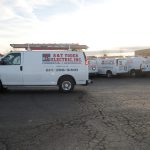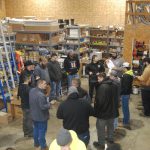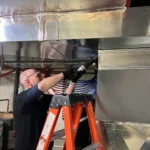A professional HVAC inspection is crucial for maintaining the health and efficiency of your heating and cooling systems. These inspections ensure your equipment operates smoothly, minimizing the chances of unexpected breakdowns and costly repairs. By knowing what happens during an HVAC inspection, you can be well-prepared for the process and maximize your system’s performance. This article will walk you through every step of a comprehensive HVAC inspection, from the initial assessment to the final recommendations.
Why Regular HVAC Inspections Are Important
Ensuring System Efficiency
Routine HVAC inspections are essential for preserving system efficiency. Over time, dust, debris, and general wear can degrade your HVAC system’s performance. Regular inspections ensure your equipment runs smoothly, consumes less energy, and maintains consistent temperatures in your home, all while preventing energy bill spikes.
Extending Equipment Lifespan
Regular HVAC inspections help extend the lifespan of your heating and cooling systems. By identifying minor issues, such as worn belts or dirty coils, before they escalate, inspections reduce excessive wear and tear on your system. This routine maintenance ensures that your equipment operates effectively for many years, preventing the need for early replacement.
When to Schedule an HVAC Inspection
Seasonal Tune-ups for Optimal Performance
The ideal time to schedule an HVAC inspection is during seasonal transitions—before the summer heat or winter chill sets in. These seasonal tune-ups prepare your HVAC system for the temperature demands ahead, ensuring peak performance throughout extreme weather conditions.
Signs That Indicate It’s Time for an Inspection
Aside from routine seasonal maintenance, certain signs indicate it’s time for an HVAC inspection. Unusual noises, weak airflow, uneven temperatures, and higher energy bills are clear indicators of potential problems. Addressing these early warnings through an inspection can help prevent major system failures.
Preparing for the HVAC Inspection
What Homeowners Should Do Before the Appointment
Before the HVAC technician arrives, clear any clutter around your indoor and outdoor units. Ensure that the technician has easy access to the thermostat, vents, and main system components. This preparation streamlines the HVAC inspection process, allowing the technician to perform the inspection efficiently.
Arrival of the HVAC Technician
What to Expect When the Technician Arrives
When the HVAC technician arrives, they will introduce themselves and explain the inspection process. They may ask you questions about your system’s performance and any issues you’ve noticed. This helps them focus on potential problem areas during the inspection and ensures that your concerns are addressed.
Initial System Assessment
Visual Inspection of Equipment and Components
The technician will begin the HVAC inspection with a visual assessment of your system’s components, including the outdoor condenser unit, furnace, or heat pump. They will look for signs of wear, damage, or corrosion. This visual assessment helps detect any obvious issues that need immediate attention.
Checking the Thermostat
Verifying Calibration and Functionality
The thermostat controls the temperature in your home, so proper calibration is crucial for comfort. The technician will check to ensure your thermostat is functioning accurately. If necessary, they may recalibrate it or recommend upgrading to a more energy-efficient model, such as a programmable or smart thermostat.
Air Filter Inspection and Replacement
Importance of Clean Filters for Efficiency
Air filters play a key role in maintaining system efficiency. During the HVAC inspection, the technician will inspect your air filters and replace them if they are clogged or dirty. Clean filters ensure proper airflow, which prevents strain on your HVAC system and helps reduce energy consumption.
Examining the Ductwork
Looking for Leaks, Blockages, and Damage
The ductwork distributes conditioned air throughout your home. During the HVAC inspection, the technician will check for leaks, blockages, or damage in the ducts. Leaky ducts reduce airflow efficiency, causing uneven temperatures and higher energy consumption. Repairing these issues ensures improved airflow and performance.
Inspecting Electrical Connections
Ensuring Safe and Efficient Operation
HVAC systems rely on a network of electrical connections. The technician will inspect these connections to ensure they are secure and free from corrosion. Loose or faulty connections can pose safety risks and reduce the system’s performance. Tightening and cleaning these connections helps prevent electrical issues and improves system efficiency.
Testing Airflow and Ventilation
Measuring Air Pressure and Ensuring Proper Circulation
Airflow is critical for maintaining comfort and system efficiency. During the HVAC inspection, the technician will measure the system’s airflow and ventilation to ensure proper air circulation. If weak airflow is detected, the technician will investigate potential causes, such as blocked vents or malfunctioning fans.
Refrigerant Level Check
Evaluating Refrigerant Levels for Optimal Cooling
For air conditioning and heat pump systems, refrigerant levels are essential for efficient cooling. During the HVAC inspection, the technician will check refrigerant levels to ensure they are within the proper range. Low refrigerant levels can impair cooling performance and increase energy use. If necessary, the technician will recharge the system and check for leaks.
Inspecting and Cleaning Coils
Maintaining Efficiency and Preventing Breakdowns
The evaporator and condenser coils play a key role in the cooling process. Over time, they can accumulate dirt and debris, reducing their efficiency. The technician will inspect the coils during the HVAC inspection and clean them if needed. Clean coils improve heat transfer, which helps your HVAC system run more efficiently and prevents breakdowns.
Combustion Safety Check (for Furnaces)
Ensuring Safe Gas and Oil Combustion
For homes with gas or oil furnaces, combustion safety is vital. During the HVAC inspection, the technician will check burners, heat exchangers, and venting systems to ensure safe combustion and proper venting of gases. This check helps prevent dangerous conditions, such as carbon monoxide leaks, ensuring both safety and efficiency.
Energy Efficiency Recommendations
Suggestions for Enhancing System Performance
After evaluating your system, the technician may offer recommendations to improve energy efficiency. These suggestions could include upgrading insulation, sealing ductwork, or installing a programmable thermostat. Following these recommendations can help reduce energy consumption, lower utility bills, and optimize your system’s performance.
Report and Next Steps
What to Expect After the Inspection Is Completed
At the end of the HVAC inspection, the technician will provide a detailed report outlining any necessary repairs, maintenance tasks, and energy efficiency improvements. This report ensures you are aware of any issues and can take the appropriate steps to keep your system running smoothly. Depending on the findings, you may need to schedule follow-up repairs or regular maintenance.
A professional HVAC inspection is essential for maintaining the efficiency, safety, and longevity of your heating and cooling systems. Regular inspections help prevent costly repairs and optimize performance, ensuring that your system operates at peak efficiency. From checking the thermostat and cleaning coils to testing refrigerant levels and airflow, every step of the process is designed to keep your home comfortable and energy-efficient. Scheduling regular inspections is the key to ensuring a comfortable, well-maintained home for years to come.







